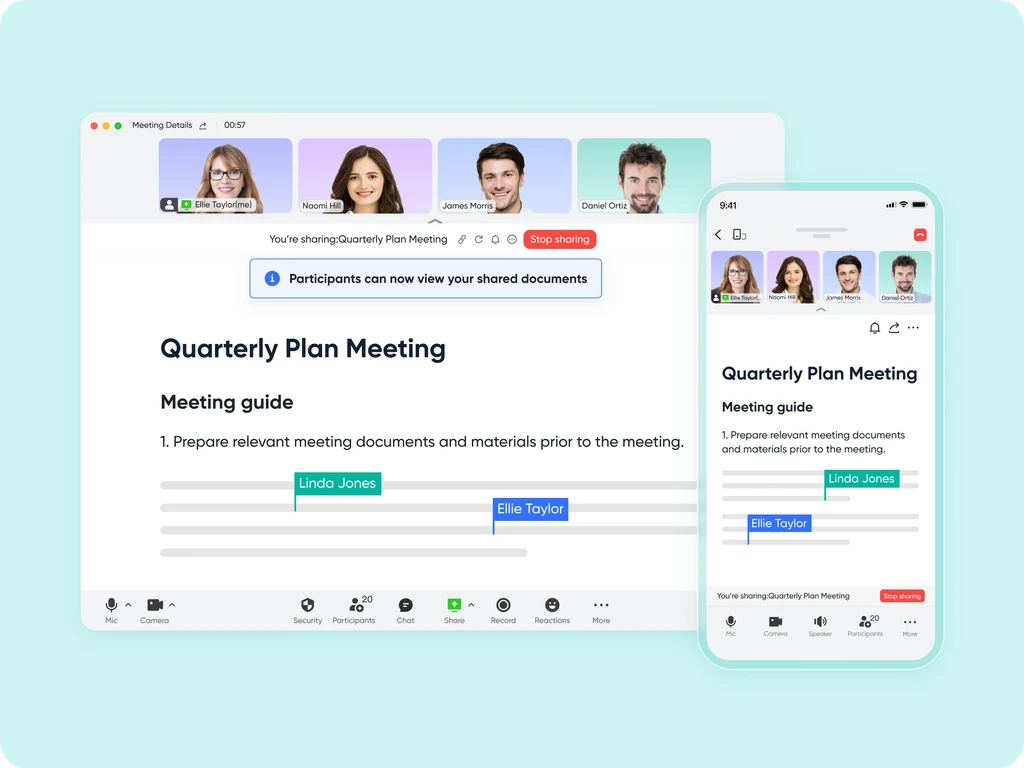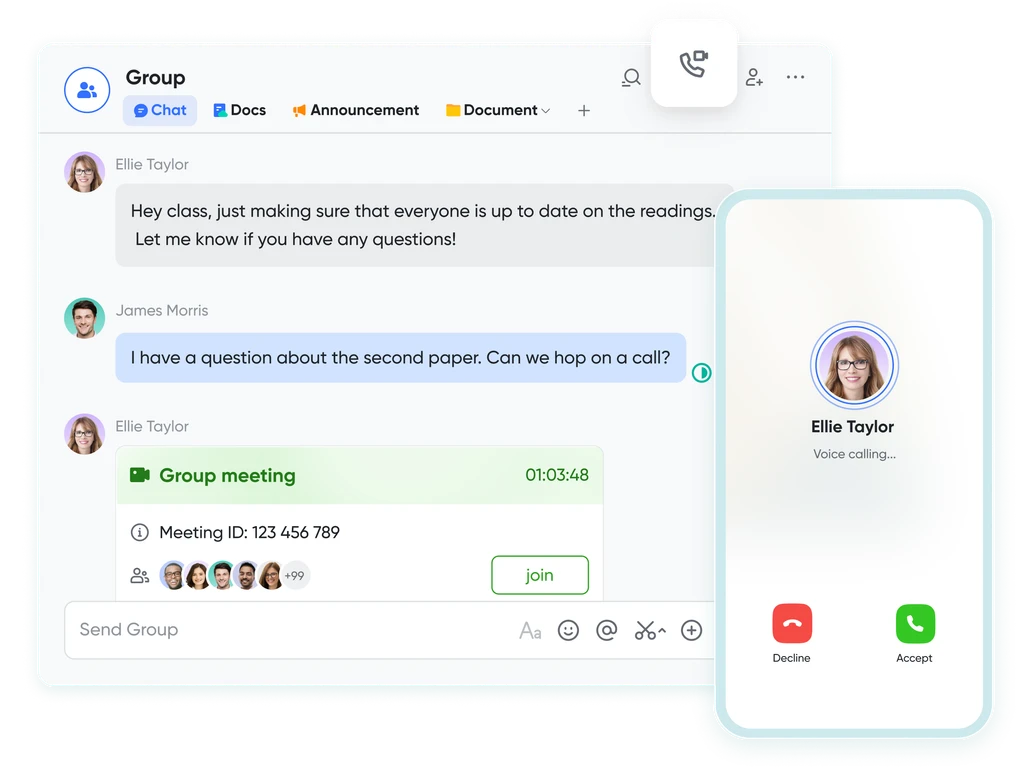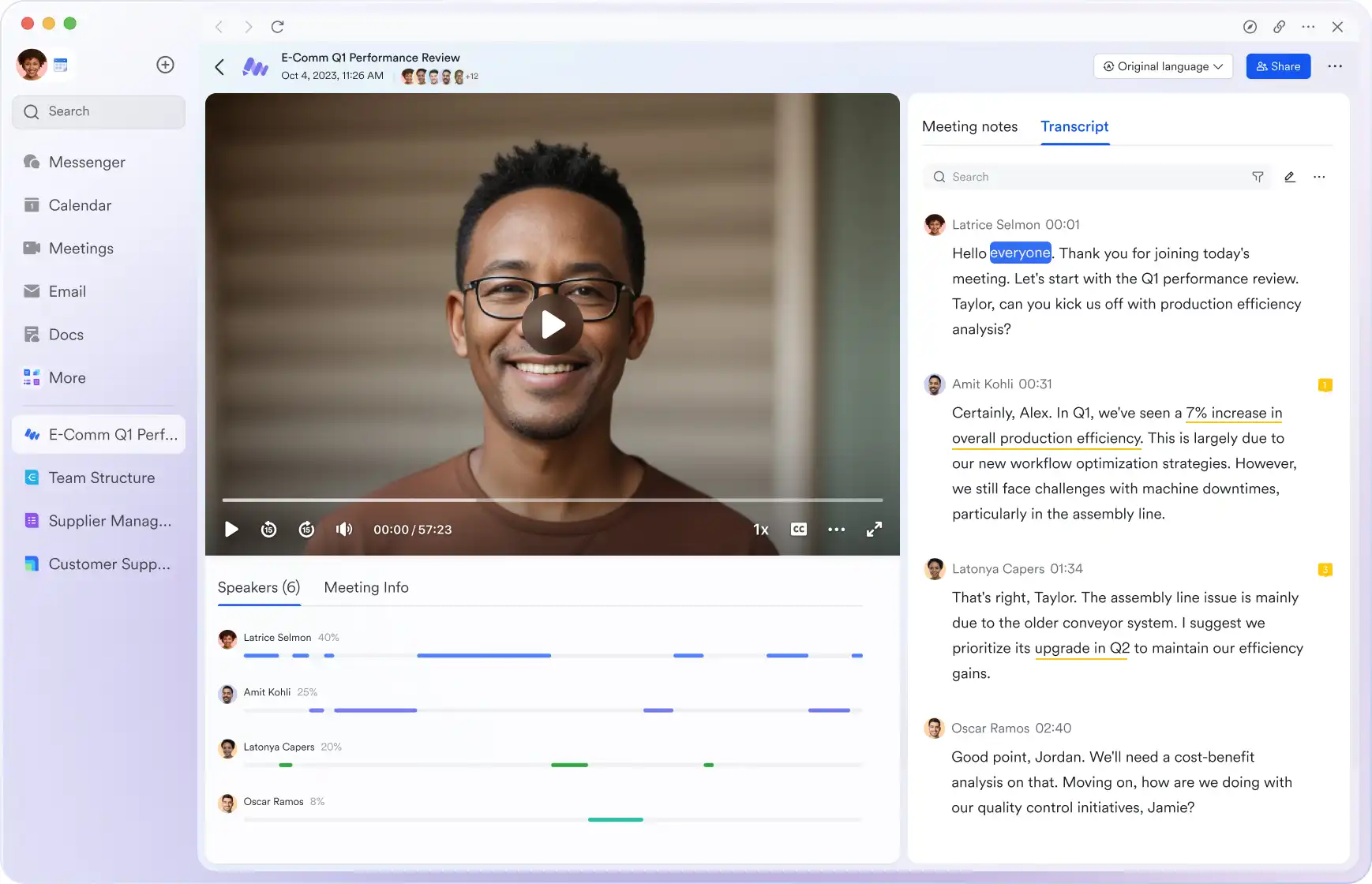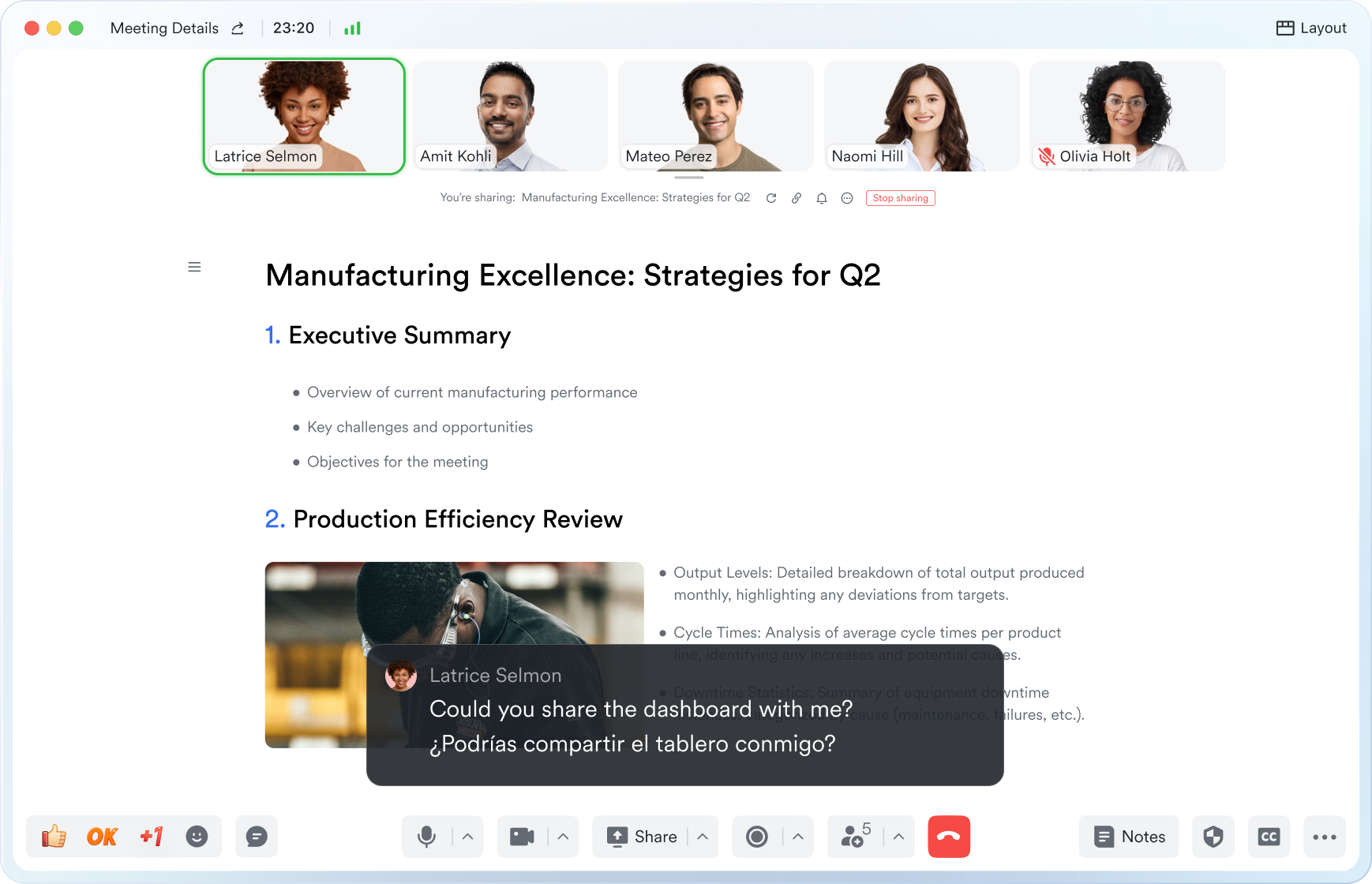Team Building Meeting
This guide will walk you through the essential elements of use team building meeting to keep your attendees aligned and engaged.
Try Lark for Free
In the rapidly evolving landscape of modern-day workplaces, fostering a cohesive and motivated team is essential for achieving collective success. A pivotal aspect of nurturing a cohesive team is through well-organized and impactful team building meetings. As we venture into 2024, the dynamics of teamwork and collaboration continue to evolve, necessitating a contemporary approach to hosting team building meetings that resonate with the current workforce. This comprehensive guide delves into the nuances of hosting a successful team building meeting in 2024, offering insights, strategies, and best practices to inspire and instill a sense of purpose within your team.
Use Lark Meetings to turn meetings into true collaborative experiences.
What is a team building meeting?
A team building meeting serves as a dedicated platform for team members to engage in activities aimed at strengthening their interpersonal relationships, improving communication, fostering trust, and enhancing collaboration. These meetings aim to create a positive and supportive work environment, ultimately driving increased team performance and productivity. The activities within a team building meeting often encourage problem-solving, creativity, and teamwork, thereby promoting a sense of unity and shared purpose among team members.
Goals of a team building meeting
The primary objectives of a team building meeting include:
- Establishing clear communication channels and promoting open dialogue
- Building trust and empathy among team members
- Enhancing problem-solving skills and promoting creativity
- Strengthening team dynamics and fostering a sense of collective responsibility
Who should attend a team building meeting?
A well-rounded team building meeting typically involves the participation of all team members, including leadership, managers, and individual contributors. In addition, the inclusion of remote team members, if applicable, ensures that the entire team is united in their focus on collective goals. The diversity of representation within the team ensures varied perspectives and experiences are brought to the fore, enriching the overall team building experience.
Related:
Unlock the Power of Webinars: A Comprehensive Guide to Boost Your Business | Lark Blog | Lark BlogLearn more about Lark x Meetings
Topics, agenda, and structure of a team building meeting
Crafting a well-defined agenda for a team building meeting is crucial for achieving the desired outcomes. The agenda should include a blend of interactive activities, discussions, and reflective sessions that align with the goals of the meeting. The structure of the meeting should allow for a seamless flow of activities, ensuring a balance between focused discussions and engaging team activities. From icebreaker sessions to strategic problem-solving exercises, the agenda should strategically address key aspects of team dynamics to achieve the desired impact.
Step-by-Step Guide to Host a Team Building Meeting
Pre-Meeting Preparations
- Determine the objectives and desired outcomes of the meeting.
- Select a suitable venue or virtual platform for hosting the meeting.
- Arrange necessary materials and equipment for planned activities.
- Communicate the agenda and details to all participants well in advance.
Meeting Facilitation
- Set a positive tone and create a welcoming environment.
- Introduce the agenda and reiterate the purpose of the meeting.
- Guide the team through the planned activities, ensuring active participation and engagement.
- Allow time for reflections, feedback, and action planning.
Post-Meeting Evaluation
- Gather feedback from participants regarding their experience and takeaways.
- Assess the impact of the meeting on team dynamics and collaboration.
- Identify areas of improvement for future team building meetings.
- Communicate and celebrate the achievements and breakthroughs from the meeting.
How often does a team building meeting occur?
The frequency of team building meetings varies based on the team’s size, dynamics, and organizational objectives. While some teams may benefit from frequent or intermittent team building activities, others may find annual team building events more suitable. In addition, integrating team building strategies into regular team meetings and project milestones can foster ongoing team development.
Learn more about Lark x Meetings
Key difference between a team building meeting and another similar meeting
A team building meeting distinctly focuses on fostering team dynamics, enhancing collaboration, and nurturing a sense of collective purpose. Unlike typical staff meetings or training sessions, team building meetings prioritize interactive activities and discussions aimed at improving interpersonal relationships, problem-solving skills, and team cohesion. By creating a supportive and engaging environment, team building meetings set themselves apart in their strategic focus on team development.
Three practical examples of team building meetings
Example 1: innovative problem-solving
Example 1: innovative problem-solving
In this scenario, the team engaged in a problem-solving activity that required collaboration, creativity, and critical thinking. By working together to find solutions, team members developed a deeper understanding of each other's strengths and contributions, fostering a sense of unity and shared accomplishment.
Example 2: trust-building exercise
Example 2: trust-building exercise
One team building meeting incorporated trust-building activities that encouraged open communication and vulnerability among team members. The collective experience led to strengthened trust and cooperation within the team, laying a foundation for improved collaboration and mutual support.
Example 3: skills enhancement workshop
Example 3: skills enhancement workshop
A team building meeting focused on skill enhancement through workshops and knowledge-sharing sessions. By embracing continuous learning and collective skill development, the team reinforced a culture of growth and agility, preparing them to adapt to evolving challenges.
Learn more about Lark x Meetings
Common pitfalls of a team building meeting
While team building meetings offer significant benefits, several common pitfalls can hinder their effectiveness if not addressed proactively. Some of these pitfalls include:
- Lack of Participant Engagement: When participants are disengaged or uninterested, the meeting's impact diminishes.
- Mismatched Activities: Choosing activities that do not align with the team's interests, abilities, or objectives can lead to dissatisfaction and disengagement.
- Unclear Objectives: Failing to communicate the purpose and expected outcomes of the meeting can lead to confusion and lack of direction.
- Resistance to Change: Some team members may resist the idea of team building, impeding the meeting's success.
To mitigate these pitfalls, proactive planning, open communication, and a nuanced understanding of team dynamics are imperative.
Dos and don’ts of a team building meeting
| Do’s | Don’ts |
|---|---|
| Encourage active participation | Force participation |
| Foster a supportive and inclusive environment | Overwhelm participants with excessive activities |
| Clearly communicate the meeting’s objectives | Impose mandatory activities without consensus |
| Celebrate team achievements and breakthroughs | Disregard individual preferences and comfort levels |
| Seek feedback and involve the team in planning | Underestimate the importance of post-meeting evaluation |
Learn more about Lark x Meetings
What makes a virtual team building meeting success?
In the digital age, virtual team building meetings have become essential in bridging geographical gaps and fostering collaboration within remote teams. Leveraging technology to create engaging, interactive, and inclusive experiences is imperative for the success of virtual team building meetings. Through the use of virtual platforms, interactive tools, and strategic facilitation, remote teams can forge meaningful connections and build strong, cohesive dynamics.
Typical takeaways of the team building meeting
The benefits and outcomes of a successful team building meeting extend beyond the meeting itself. Some typical takeaways include:
- Strengthened team camaraderie and trust
- Enhanced communication and problem-solving skills
- A sense of shared purpose and commitment among team members
- Increased morale and motivation within the team
Learn more about Lark x Meetings
Questions to ask in the team building meeting
To stimulate meaningful discussions and insights, consider incorporating the following questions into your team building meeting:
- What are our collective strengths as a team, and how can we leverage them to achieve our goals?
- How can we better support and understand each other's working styles and preferences?
- What collective challenges do we face, and how can we address them as a unified team?
- What specific actions can we take to sustain the positive outcomes of this meeting and build upon them?
Conclusion
As the workplace landscape continues to evolve, the essence of effective team building meetings remains an integral aspect of nurturing high-performing teams. By leveraging the strategies and insights delineated in this guide, you're poised to foster a vibrant and interconnected team that thrives on collaboration, mutual trust, and a resolute focus on shared objectives.
Related:
Unlock the Power of Webinars: A Comprehensive Guide to Boost Your Business | Lark Blog | Lark BlogLearn more about Lark x Meetings
Use Lark Meetings to turn meetings into true collaborative experiences.
A Game Changer for Team Building Meeting: Empower your team with Lark Meetings
In the fast-paced and dynamic world of modern business, effective communication and collaboration are crucial for success of Team Building Meeting. Here we introduce Lark Meetings to serve as a centralized hub for all communication needs.
Transform your meetings into collaborative endeavors

Leverage the potency of in-call document sharing, intelligent meeting minutes, and mobile-optimized features to enhance productivity collaboratively, irrespective of your location or schedule.
Seamlessly collaborate in real-time, across any device

Share live documents instead of just screen views. Participants can navigate and edit simultaneously within the video call window, even while on the move.
Shift your focus to engagement, not note-taking

Lark Minutes automatically converts video meetings into transcripts, facilitating easy viewing, searching, and collaborative editing. Stay in the loop asynchronously, even if you can't attend the live meeting. Lark Minutes for meeting minutes support translation into 10+ different languages.
Break language barriers in communication

Lark Meetings provide real-time translation for subtitles, allowing individuals from diverse backgrounds to express themselves in their native languages. Ensure every voice is heard, regardless of geographical location. Live subtitles currently support translations from English, Chinese, and Japanese to 10+ different languages. See more translation feature in Lark.
Connect with larger audiences
Host dynamic online meetings and events accommodating up to 1,000 participants, with the flexibility of up to 50 breakout sessions for intimate group discussions within the larger meeting context. Try more Lark features for free.








